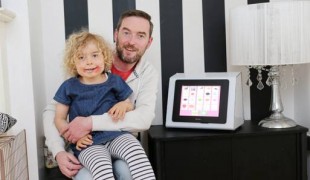- 5673
- 471
- 5
- 3
- 0
- Help Ukraine
About the solution
When her younger son was diagnosed with Autism, Denise quickly became educated on the use of Visual Cues – single-image pictures that help those with language and communication challenges perform everyday tasks.
Since people with Autism think in pictures, visual cues help them follow a schedule, manage behavior, tolerate new activities, and communicate with others.
Denise’s son’s behavior and language skills improved dramatically with the use of visual cues, but the cues were often time-consuming to make and cumbersome to transport and manage.
She also wanted to share this communication method with other parents to experience the success her child had with visual cues, so Denise realized that she needed to create visual cues that would be portable, fashionable and fun to use.
Denise then had an "aha" moment. While her visual cues box was in another room, she thought of the idea of wearing visual cues and thought, “if I only had cues on a bracelet, then I could capture teachable moments in any setting!”, Denise said.
From that moment, she began creating the QCharm Portable Visual Cue System, which displays visual cues printed on flat surfaced charms that clip onto silicone wristbands.
Since starting QCharm in 2006, Denise says the greatest benefit has been seeing the positive ways in which the QCharm has helped other caregivers and educators manage their loved one’s needs more easily, so much so that they are able to leave their houses more often to participate in activities with others and enjoy more of what life has to offer.
Denise hasn't finished and has future plans to market QCharm nationally and generate awareness of her business and the power of visual cues that can help families and caregivers enjoy easy communication.
With the support of The UPS Store small business solutions, Denise will be brainstorming ideas to get the word out!
https://longitudes.ups.com/qcharm/
behance.net/QCharm/info
https://www.youtube.com/watch?v=CIH9rqlKdww
This solution shall not include mention to the use of drugs, chemicals or biologicals (including food); invasive devices; offensive, commercial or inherently dangerous content. This solution was not medically validated. Proceed with caution! If you have any doubts, please consult with a health professional.
DISCLAIMER: This story was written by someone who is not the author of the solution, therefore please be advised that, although it was written with the utmost respect for the innovation and the innovator, there can be some incorrect statements. If you find any errors please contact the patient Innovation team via info@patient-innovation.com
-
-
339
-
0
-
3835

Mother creates bracelet with visual cues to help autistic patients
COMMUNICATION: Communicating, whether by speaking, listening, or other means
Autism
Body-Worn solutions (Clothing, accessories, shoes, sensors...)
Assistive Daily Life Device (to help ADL)
Anxiety
Difficulty concentrating or making decisions
Irritability or anger outbursts
Restlessness or feeling slowed down
Loss of interest or pleasure in activities (anhedonia)
Sleep disturbances
Managing Neurological Disorders
Enhancing Mental Health
Improving Speech and Communication
Child and Adolescent Psychiatry
Pediatrics
Psychiatry
United States
-
-
-
387
-
0
-
4041

Student designs sensory pod inspired by autistic son
CAREGIVING
COMMUNICATION: Communicating, whether by speaking, listening, or other means
Attend Concerts/Performances
Autism
Strategy/Tip
Assistive Daily Life Device (to help ADL)
Irritability or anger outbursts
Panic attacks
Racing thoughts
Feelings of guilt or worthlessness
Fatigue
Promoting self-management
Building Supportive Community Relationships
Promoting inclusivity and social integration
Enhancing Mental Health
Improving Speech and Communication
Preventing (Vaccination, Protection, Falls, Research/Mapping)
Raise awareness
Caregiving Support
Child and Adolescent Psychiatry
General and Family Medicine
Pediatrics
Psychiatry
United Kingdom
-
-
-
526
-
0
-
7210

Father invents app for autistic daughter
COMMUNICATION: Communicating, whether by speaking, listening, or other means
Autism
Asperger's Syndrome
App (Including when connected with wearable)
Anxiety
Difficulty concentrating or making decisions
Social withdrawal or isolation
Restlessness or feeling slowed down
Loss of interest or pleasure in activities (anhedonia)
Managing Neurological Disorders
Enhancing Mental Health
Improving Speech and Communication
Child and Adolescent Psychiatry
Pediatrics
Psychiatry
Ireland
-
 en
en